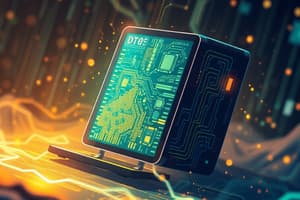Podcast
Questions and Answers
Which of the following is NOT a type of digital evidence commonly found in mobile device forensics?
Which of the following is NOT a type of digital evidence commonly found in mobile device forensics?
- System logs (correct)
- Call logs
- Location data
- App data
What is the primary goal of network forensics?
What is the primary goal of network forensics?
- Analyzing the structure and organization of file systems
- Extracting data directly from a device's storage
- Recovering fragmented or deleted files
- Identifying and investigating network-related security incidents (correct)
Which of these is a common technique used in general digital forensics to verify the integrity of a file?
Which of these is a common technique used in general digital forensics to verify the integrity of a file?
- Chip-off extraction
- Physical extraction
- Logical extraction
- Hashing (correct)
Which of the following is NOT a type of digital evidence typically found in cloud forensics?
Which of the following is NOT a type of digital evidence typically found in cloud forensics?
What is the primary objective of data carving in digital forensics?
What is the primary objective of data carving in digital forensics?
Which of these is a technique specifically used in mobile device forensics?
Which of these is a technique specifically used in mobile device forensics?
What type of digital evidence would most likely be obtained during a network forensics investigation?
What type of digital evidence would most likely be obtained during a network forensics investigation?
Which of the following is a type of digital evidence commonly found in both computer and mobile device forensics?
Which of the following is a type of digital evidence commonly found in both computer and mobile device forensics?
What is the purpose of packet capture in network forensics?
What is the purpose of packet capture in network forensics?
Which technique involves examining cloud data for signs of security breaches?
Which technique involves examining cloud data for signs of security breaches?
What is the main focus of registry analysis in computer forensics?
What is the main focus of registry analysis in computer forensics?
Which method is used to detect and investigate suspicious activity on a network?
Which method is used to detect and investigate suspicious activity on a network?
What does disk imaging involve in computer forensics?
What does disk imaging involve in computer forensics?
What is the primary purpose of forensic experts in the legal system?
What is the primary purpose of forensic experts in the legal system?
Which phase of digital forensics involves ensuring the integrity of evidence?
Which phase of digital forensics involves ensuring the integrity of evidence?
Which type of digital forensics focuses specifically on examining mobile devices?
Which type of digital forensics focuses specifically on examining mobile devices?
What type of evidence in digital forensics can include text, audio, and video?
What type of evidence in digital forensics can include text, audio, and video?
What does the analysis phase of digital forensics involve?
What does the analysis phase of digital forensics involve?
What type of forensics deals with the examination of databases?
What type of forensics deals with the examination of databases?
Which is NOT a key phase of digital forensics?
Which is NOT a key phase of digital forensics?
Which type of evidence might be used to reconstruct a crime scene?
Which type of evidence might be used to reconstruct a crime scene?
What is the primary goal of forensics?
What is the primary goal of forensics?
What percentage of security breaches were detected by business and government agencies, as mentioned?
What percentage of security breaches were detected by business and government agencies, as mentioned?
In the early 1990s, what was the estimated ratio of internal to external threats to information systems?
In the early 1990s, what was the estimated ratio of internal to external threats to information systems?
What type of crime activities can potentially target computers and networks?
What type of crime activities can potentially target computers and networks?
Which of the following best describes digital forensics?
Which of the following best describes digital forensics?
What new business model has emerged due to the widespread use of computers and networks?
What new business model has emerged due to the widespread use of computers and networks?
According to the Federal Bureau of Investigation, what is the estimated annual loss from cybercrime in the U.S.?
According to the Federal Bureau of Investigation, what is the estimated annual loss from cybercrime in the U.S.?
What has contributed to the increase in threats to information systems?
What has contributed to the increase in threats to information systems?
Which of the following tools is specifically used for memory forensics?
Which of the following tools is specifically used for memory forensics?
What is a common step performed in all mobile device forensics tools listed?
What is a common step performed in all mobile device forensics tools listed?
Which tool is primarily used for acquisition and presentation in cloud forensics?
Which tool is primarily used for acquisition and presentation in cloud forensics?
Which of the following tools includes detection as a step?
Which of the following tools includes detection as a step?
Which type of forensics is primarily concerned with network activities?
Which type of forensics is primarily concerned with network activities?
What is NOT an application of digital forensics listed?
What is NOT an application of digital forensics listed?
Which tool is designed for general-purpose use and includes both acquisition and presentation as steps?
Which tool is designed for general-purpose use and includes both acquisition and presentation as steps?
Identify which of the following tools specializes in network forensics detection?
Identify which of the following tools specializes in network forensics detection?
Flashcards
What is Digital Forensics?
What is Digital Forensics?
The scientific process of finding, keeping safe, studying, and presenting digital evidence in a courtroom.
Identification (Digital Forensics)
Identification (Digital Forensics)
The process of recognizing and pinpointing potential sources of digital evidence.
Preservation (Digital Forensics)
Preservation (Digital Forensics)
Making a copy of digital evidence to keep it original and unchanged.
Acquisition (Digital Forensics)
Acquisition (Digital Forensics)
Signup and view all the flashcards
Analysis (Digital Forensics)
Analysis (Digital Forensics)
Signup and view all the flashcards
Presentation (Digital Forensics)
Presentation (Digital Forensics)
Signup and view all the flashcards
Digital Evidence
Digital Evidence
Signup and view all the flashcards
Mobile Device Forensics
Mobile Device Forensics
Signup and view all the flashcards
What is Forensics?
What is Forensics?
Signup and view all the flashcards
What is Evidence?
What is Evidence?
Signup and view all the flashcards
What is Digital Evidence?
What is Digital Evidence?
Signup and view all the flashcards
How has everyday life impacted crime investigations?
How has everyday life impacted crime investigations?
Signup and view all the flashcards
How are computers used in modern businesses?
How are computers used in modern businesses?
Signup and view all the flashcards
What threats are faced by computers and networks?
What threats are faced by computers and networks?
Signup and view all the flashcards
How have threats to information systems evolved?
How have threats to information systems evolved?
Signup and view all the flashcards
Packet Capture
Packet Capture
Signup and view all the flashcards
Protocol Analysis
Protocol Analysis
Signup and view all the flashcards
Flow Analysis
Flow Analysis
Signup and view all the flashcards
Port Scanning
Port Scanning
Signup and view all the flashcards
Intrusion Detection
Intrusion Detection
Signup and view all the flashcards
Digital Forensics
Digital Forensics
Signup and view all the flashcards
File Data in Digital Forensics
File Data in Digital Forensics
Signup and view all the flashcards
Metadata in Digital Forensics
Metadata in Digital Forensics
Signup and view all the flashcards
System Logs in Digital Forensics
System Logs in Digital Forensics
Signup and view all the flashcards
Network Forensics
Network Forensics
Signup and view all the flashcards
Cloud Forensics
Cloud Forensics
Signup and view all the flashcards
Data Carving in Digital Forensics
Data Carving in Digital Forensics
Signup and view all the flashcards
General-purpose Forensics
General-purpose Forensics
Signup and view all the flashcards
Memory Forensics
Memory Forensics
Signup and view all the flashcards
Acquisition
Acquisition
Signup and view all the flashcards
Analysis
Analysis
Signup and view all the flashcards
Presentation
Presentation
Signup and view all the flashcards
Study Notes
Introduction to Digital Forensics
- Digital forensics is the scientific process of identifying, preserving, analyzing, and presenting digital evidence in a court of law.
- The process involves examining digital media devices such as computers, smartphones, servers, and storage devices.
Background
- Cyber activity has become a significant part of everyday life for the general public.
- The scope of crime investigation has broadened.
- Computers and networks are now used widely for enterprise information processing.
- E-commerce (B2B, B2C, C2C) has become a new business model.
- Many facilities are directly controlled by computers.
- Computers and networks are targets for criminal activities like theft, vandalism, espionage, and even cyber warfare.
- 85% of businesses and government agencies have detected security breaches.
- FBI estimates US losses are up to $10 billion per year.
- In the early 1990s, threats to information systems were roughly 80% internal and 20% external.
- With the integration of telecommunications and personal computers into the internet, threats are now nearly evenly split between internal and external agents.
Forensics and Evidence
- Forensics is the application of scientific methods to investigate crimes and gather evidence.
- The goal of forensics is to provide objective evidence usable in legal proceedings.
- Evidence is anything used to prove or disprove a fact, taking various forms in forensics, including physical, testimonial, and documentary evidence.
- Forensic experts play a crucial role in the legal system by identifying suspects, proving guilt or innocence, and reconstructing crime scenes.
What is Digital Forensics?
- Digital forensics is a scientific process of identifying, preserving, analyzing, and presenting digital evidence in law.
- Key phases include:
- Identification (recognizing and identifying potential digital evidence sources)
- Preservation (ensuring evidence integrity by making copies and preventing alteration)
- Acquisition (extracting data from devices using specialized tools)
- Analysis (examining extracted data for relevant information or patterns)
- Presentation (preparing detailed reports or testimony for court)
Digital Evidence
- Digital data linking a crime to its victim or perpetrator.
- Examples include text, audio, image, and video data.
Types of Digital Forensics
- Digital forensics can be categorized based on the examined evidence type.
- Computer forensics
- Mobile device forensics
- Network forensics
- Database forensics
- Cloud forensics
- Internet forensics
- Memory forensics
- Digital audio and video forensics
Computer Forensics
- Examining computers and other digital devices to recover and analyze digital evidence.
- Types of digital evidence in computer forensics include files, metadata, registry entries, system logs, network traffic, temporary files, deleted files, and hidden files.
Mobile Device Forensics
- Examining smartphones, tablets, and other mobile devices for digital evidence.
- Types of digital evidence include call logs, text messages, multimedia files, contacts, calendar events, app data, browser history, location data, Wi-Fi and Bluetooth connections, and SIM card data
Network Forensics
- Examining network traffic to identify and investigate security incidents, cybercrimes, and network issues.
- Types of digital evidence include network packets, network logs, firewall logs, intrusion detection system (IDS) logs, DNS logs, web server logs, and email server logs.
Cloud Forensics
- Investigating digital evidence stored in cloud-based environments (cloud storage, cloud applications, cloud infrastructure).
- Types of digital evidence include cloud logs, API logs, virtual machine images, cloud storage data, cloud application data, and network traffic.
Common Digital Forensic Techniques
- General techniques:
- Data carving (recovering deleted or fragmented files)
- File system analysis (examining file system structure)
- Digital watermarking (identifying ownership or copyright)
- Steganography (detecting hidden messages)
- Hashing (creating a unique digital fingerprint)
- Mobile device forensics:
- Physical extraction (extracting data directly)
- Logical extraction (extracting data from backups or using tools)
- Chip-off extraction (removing flash memory for analysis)
- SIM card analysis (examining SIM card data)
- App data extraction (extracting data from installed apps)
- Network forensics:
- Packet capture (capturing network traffic using tools like Wireshark or tcpdump)
- Protocol analysis (analyzing network protocols to detect suspicious activity)
- Flow analysis (analyzing data flow between devices)
- Port scanning (identifying open ports on a network)
- Intrusion detection (detecting suspicious activity using IDS tools)
- Cloud forensics:
- Cloud data acquisition (obtaining cloud data legally or through cooperation)
- Cloud data analysis (analyzing cloud data for relevant information)
- Cloud API analysis (analyzing API logs for suspicious activity)
- Virtual machine forensics (examining virtual machines for evidence)
- Computer forensics
- Registry analysis (examining Windows Registry)
- System log analysis (analyzing system logs for security incidents)
- Artifact analysis (examining digital artifacts)
- Disk imaging (creating images of storage devices for analysis)
Digital Forensic Tools
- Various tools, specific to each type of forensics, exist to assist
- Some tools examples are shown (the complete list is likely much longer)
Applications of Digital Forensics
- Cybercrime investigation
- Intellectual property theft
- Corporate espionage
- Legal disputes
- Incident response
Studying That Suits You
Use AI to generate personalized quizzes and flashcards to suit your learning preferences.




